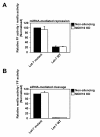Endogenous MOV10 inhibits the retrotransposition of endogenous retroelements but not the replication of exogenous retroviruses
- PMID: 22727223
- PMCID: PMC3408377
- DOI: 10.1186/1742-4690-9-53
Endogenous MOV10 inhibits the retrotransposition of endogenous retroelements but not the replication of exogenous retroviruses
Abstract
Background: The identification of cellular factors that regulate the replication of exogenous viruses and endogenous mobile elements provides fundamental understanding of host-pathogen relationships. MOV10 is a superfamily 1 putative RNA helicase that controls the replication of several RNA viruses and whose homologs are necessary for the repression of endogenous mobile elements. Here, we employ both ectopic expression and gene knockdown approaches to analyse the role of human MOV10 in the replication of a panel of exogenous retroviruses and endogenous retroelements.
Results: MOV10 overexpression substantially decreased the production of infectious retrovirus particles, as well the propagation of LTR and non-LTR endogenous retroelements. Most significantly, RNAi-mediated silencing of endogenous MOV10 enhanced the replication of both LTR and non-LTR endogenous retroelements, but not the production of infectious retrovirus particles demonstrating that natural levels of MOV10 suppress retrotransposition, but have no impact on infection by exogenous retroviruses. Furthermore, functional studies showed that MOV10 is not necessary for miRNA or siRNA-mediated mRNA silencing.
Conclusions: We have identified novel specificity for human MOV10 in the control of retroelement replication and hypothesise that MOV10 may be a component of a cellular pathway or process that selectively regulates the replication of endogenous retroelements in somatic cells.
Figures





References
Publication types
MeSH terms
Substances
Grants and funding
LinkOut - more resources
Full Text Sources

